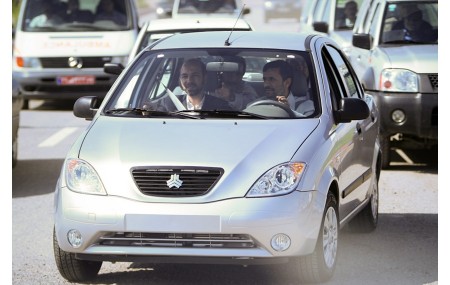Last Sunday, Iran president Mahmoud Ahmadinejad opened a car plant that is said to be the biggest in the Middle East. It belongs to state-run automobile company Saipa. Located in the city of Kashan, the US$50 million facility has the capacity to manufacture 150,000 vehicles annually.
To offer 4,000 jobs, the plant will build locally designed small cars called the Tiba (deer). The latest Tiba (pictured above), also unveiled by Ahmadinejad on the same day, is priced between US$8,000 to US$9,000, targeting lower middle-class buyers.
“This is the first Iranian vehicle with Iranian characteristics as it is designed and manufactured by Iranians. Tiba is the symbol of our confidence in ourselves. The Iranian nation has shown that despite sanctions and pressures from enemies, we have have resisted and have progressed,” the Islamic Republic’s president was quoted as saying on state owned media. “The quality of our cars should be such that if an Iranian wants to buy a vehicle, he must prefer home-made ones,” Ahmadinejad added.
Iran is the largest automobile manufacturer in the Middle East with more than 1.4 million vehicles produced last year. Of that figure, Saipa contributed 54% while state-run Iran Khodro made the rest. Saipa has tie-ups with Kia and Renault, while Iran Khodro collaborates with Peugeot. Most of the cars assembled in Iran are past gen models, with the exception of the Dacia Logan range, which is called Renault Tondar in Iran.
Here’s an interesting fact. Iran has banned importing vehicles which compete with locally made models, which have to be paid for in cash. Luxury vehicles are allowed, but only after paying 90% customs duty!
Looking to sell your car? Sell it with Carro.



AI-generated Summary ✨
Comments show a mix of admiration and criticism towards Iran's automotive achievements, highlighting their ability to develop a car industry despite international sanctions. Some express respect for Iranian leadership exemplifying simplicity and patriotism, while others mock or joke about political issues. There's recognition of Iran’s self-sufficiency, military advancements, and infrastructural strides, with some comparing Iran’s progress to Malaysia’s automotive industry. Critics mention protectionist policies and high taxes in Malaysia, contrasting it with Iran’s approach. Overall, readers acknowledge Iran’s resilience and technological progress, especially in automotive and military sectors, amid geopolitical challenges, with some sarcastic comments about car design and political remarks interjected, but the overarching sentiment is one of respect for Iran’s development trajectory.